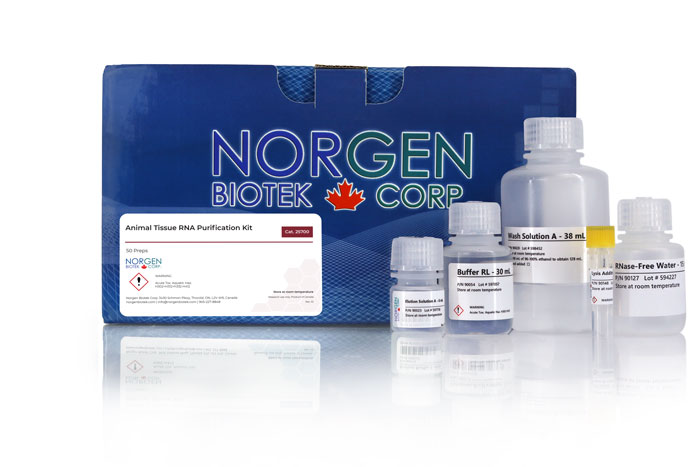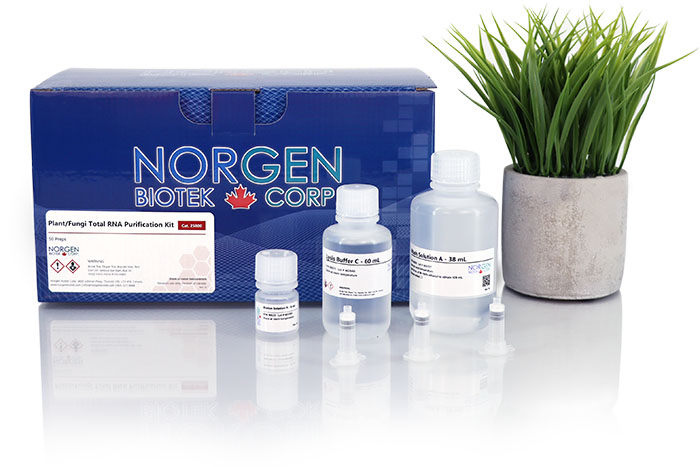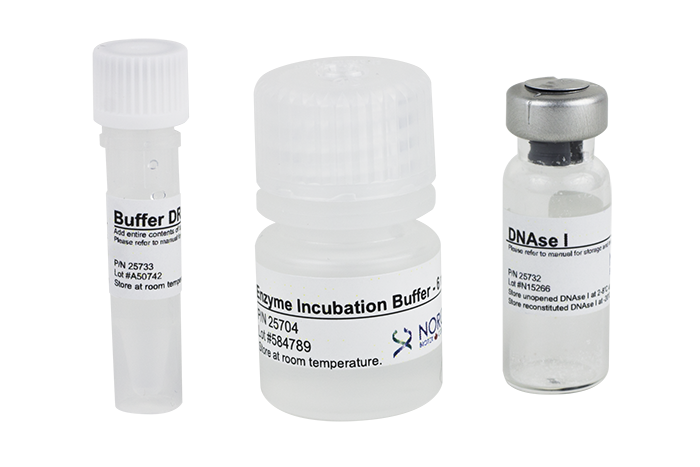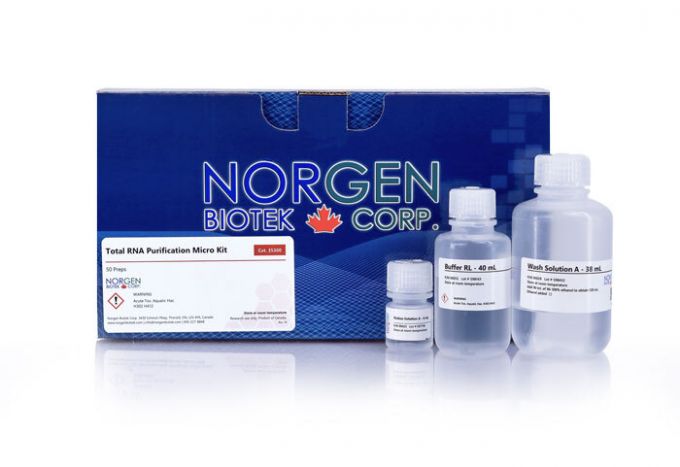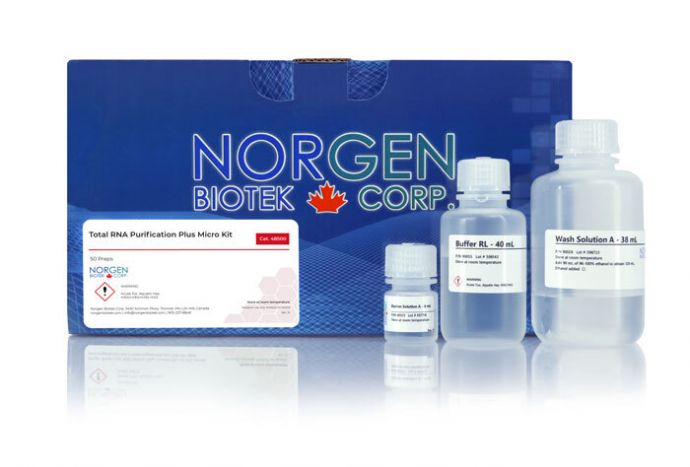Total RNA Purification Plus Kit
For the purification of total RNA - including microRNA - with rapid gDNA removal
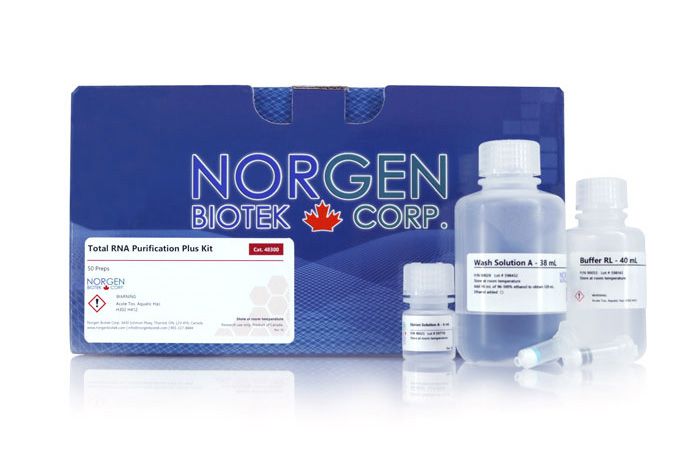
For research use only and NOT intended for in vitro diagnostics.
Total RNA Purification Plus Kit
For the purification of total RNA - including microRNA - with rapid gDNA removal
Register today to receive an exclusive 15% off* on your first order.
Features and Benefits
- Extract high quality & quantity total RNA including miRNA
- No phenol step required; isolate all RNA in one fraction
- Genomic DNA Removal Column for efficient elimination of gDNA
- Bind & elute all RNA irrespective of size or GC content, without bias
- Efficiently extract small RNA irrespective of GC content
- Very sensitive & linear down to a few cells without the need for carrier RNA
- Convenient & fast spin column format
- Isolate from a wide variety of specimens
- Purification is based on spin column chromatography that uses Norgen’s proprietary resin separation matrix
This kit purifies total RNA including miRNA from biological samples and employs an extra column for the efficient removal of contaminating gDNA, thereby replacing the enzymantic DNase step.
Efficiently extract total RNA from a range of samples including cells, bacteria, yeast, virus and bodily fluids including plasma/serum, blood, saliva, CSF and more. Extract high quality and purity RNA with excellent RIN values and A260/A280 suitable for downstream applications including qRT-PCR, RT-PCR, microarrays, NGS and more.
The kit purifies all sizes of RNA from large mRNA, lncRNA down to microRNA (miRNA) in the same fraction without the requirement of phenol. Isolate all RNA sequences at an equal rate irrespective of size. Moreover, when the RNA sequences are small (e.g. miRNA), the column binds small RNAs regardless of their GC content.
Details
Supporting Data
Figure 1. Genomic DNA Removal from HeLa cells. Norgen's Total RNA Purification Plus Kit is unique in that it contains a Genomic DNA Removal Column, allowing for gDNA removal without the use of enzymes. HeLa cells were either passed through the gDNA Removal Column, or received no gDNA removal treatment. The Genomic DNA Removal Column successfully removed gDNA from both 1 million HeLa cells (Panel A) and 1x105 HeLa cells (Panel B). For both Panels A and B, the left image displays the RNA run on a 1.2% EtBR-agarose gel, to better visualize any gDNA contamination. The right image displays a 1.0% formaldehyde-agarose gel to allow for better denaturation of RNA in the sample. For higher inputs, as in image A, the Genomic DNA Removal Column also resulted in higher RNA yields than the non-treated samples.
Figure 2. Delta Ct Values Observed Between Different gDNA Removal Techniques. Genomic DNA is well known to contaminate RNA samples, and subsequently RT-qPCR results. Therefore, to determine the amount of genomic DNA contamination in RNA samples, an RT-qPCR can be used to compare Ct values observed with and without reverse transcription of the RNA sample. This is known as the Delta Ct. One million and 1x105 HeLa cells were either passed through the gDNA Removal Column or subjected to DNase-treatment using Norgen's RNase-Free DNase I (Cat# 25710). The gDNA Removal column eliminated gDNA similar to a DNase treatment. For higher inputs (i.e. 1 Million HeLa cells), the gDNA Removal Column successfully removed more gDNA contamination from the RNA samples than the DNase-treatment. When inputs were lowered, the amount of genomic DNA contamination in the DNase-treated sample was similar to the sample passed through the gDNA Removal Column. Both methods work well for removing gDNA contamination in RNA samples.
|
Kit Specifications
|
|||
|
Maximum Binding Capacity Per Column
|
Up to 50 μg RNA
|
||
|
Maximum Loading Volume Per Spin Column
|
650 μL
|
||
|
Size of RNA Purified
|
All sizes, including < 200 nt
|
||
| Time to Complete 10 Purifications |
25 minutes
|
||
|
Maximum Amount of Starting Material
|
|||
|
Liver Tissue
|
20 mg
|
||
|
Heart Tissue
|
5 mg
|
||
|
Kidney Tissue
|
20 mg
|
||
|
Brain Tissue
|
25 mg
|
||
| Lung Tissue |
20 mg
|
||
|
Spleen Tissue
|
20 mg
|
||
|
Whole Blood
|
100 µL
|
||
|
Hela Cells
|
3 x 106
|
||
| CHO |
3 x 106
|
||
| Yeast |
1 x 108 cells
|
||
| E.coli |
1 x 109 CFU/mL
|
||
| Bacteria | 1 x 109 cells | ||
| Plasma/Serum | 200 µL | ||
| Fungi |
50 mg
|
||
| Plant Tissue |
50 mg
|
||
| Viruses |
≤100 µL of viral suspension
|
||
|
Average Yield
|
|||
|
|||
All solutions should be kept tightly sealed and stored at room temperature. This kit is stable for 1 year after the date of shipment.
Component | Cat. 48300 (50 preps) | Cat. 48400 (100 preps) |
|---|---|---|
Buffer RL | 40 mL | 2 x 40 mL |
Wash Solution A | 38 mL | 2 x 38 mL |
Elution Solution A | 6 mL | 2 x 6 mL |
RNA Purification Columns | 50 | 100 |
Genomic DNA Removal Columns | 50 | 100 |
Collection Tubes | 100 | 200 |
Elution Tubes (1.7 mL) | 50 | 100 |
Product Insert | 1 | 1 |
Documentation
FAQs
Plus
Poor RNA recovery could be due to one or more of the following:
- Incomplete lysis of cells or tissue. Ensure that the appropriate amount of Buffer RL was used for the amount of cells or tissue.
- Column has become clogged. Either the Genomic DNA Removal Column or the RNA Purification Column may become clogged if the recommended amount of starting materials is exceeded. The amount of starting material may need to be decreased if the column shows clogging below the recommended levels. See FAQ related to “Clogged Column” below.
- An alternative elution solution was used. It is recommended that the Elution Solution A supplied with this kit be used for maximum RNA recovery.
- Ethanol was not added to the lysate. Ensure that the appropriate amount of ethanol is added to the lysate before binding to the column.
- Ethanol was not added to the Wash Solution A. Ensure that 90 mL of 96 - 100% ethanol is added to the supplied Wash Solution A prior to use.
- Low RNA content in cells or tissues used. Different tissues and cells have different RNA contents, and thus the expected yield of RNA will vary greatly from these different sources. Please check literature to determine the expected RNA content of your starting material.
- Cell Culture: Cell monolayer was not washed with PBS. Ensure that the cell monolayer is washed with the appropriate amount of PBS in order to remove residual media from cells.
- Yeast: Lyticase was not added to the Resuspension Buffer. Ensure that the appropriate amount of lyticase is added when making the Resuspension Buffer.
- Bacteria and Yeast: All traces of media not removed. Ensure that all media is removed prior to the addition of Buffer RL through aspiration.
Column clogging can result from one or a combination of the following factors:
- Insufficient solubilization of cells or tissues. Ensure that the appropriate amount of lysis buffer was used for the amount of cells or tissue.
- Maximum number of cells or amount of tissue exceeds kit specifications. Refer to specifications to determine if the amount of starting material falls within kit specifications.
- High amounts of genomic DNA present in sample. The lysate may be passed through a 25 gauge needle attached to a syringe 5-10 times in order to shear the genomic DNA prior to loading onto the column.
- Centrifuge temperature is too low. Ensure that the centrifuge remains at room temperature throughout the procedure. Temperatures below 15°C may cause precipitates to form that can cause the columns to clog.
RNA can be degraded due to the following factors:
- RNase contamination. RNases may be introduced during the use of the kit. Ensure proper procedures are followed when working with RNA. Please refer to “Working with RNA” at the beginning of this user guide.
- Procedure not performed quickly enough. In order to maintain the integrity of the RNA, it is important that the procedure be performed quickly. This is especially important for the Cell Lysate Preparation Step in the Tissue Protocol, since the RNA in animal tissues is not protected after harvesting until it is disrupted and homogenized.
- Improper storage of the purified RNA. For short-term storage, RNA samples may be stored at –20°C for a few days. It is recommended that samples be stored at –70°C for longer-term storage.
- Frozen tissues were allowed to thaw prior to RNA isolation. Do not allow frozen tissues to thaw prior to grinding with a mortar and pestle in order to ensure that the integrity of the RNA is not compromised.
- Starting material may have a high RNase content. For starting materials with high RNase content, it is recommended that β-mercaptoethanol be added to the Lysis Solution.
- Lysozyme or lyticase used may not be RNase-free. Ensure that the lysozyme and lyticase being used with this kit are RNase-free, in order to prevent possible problems with RNA degradation.
If the RNA does not perform well in downstream applications, it may be due to one or more of the following:
- RNA was not washed 3 times with the provided Wash Solution A. Traces of salt from the binding step may remain in the sample if the plate is not washed 3 times with Wash Solution A. Salt may interfere with downstream applications, and thus must be washed from the column.
- Ethanol carryover. Ensure that the dry spin under the Column Wash Procedure is performed, in order to remove traces of ethanol prior to elution. Ethanol is known to interfere with many downstream applications.
The contamination with genomic DNA may be due to large amount of starting material used. Perform RNase-free DNase I digestion on the RNA sample after elution to remove genomic DNA contamination. It is recommended that Norgen’s RNase-Free DNase I Kit (Product # 25710) be used for this step.
The Total RNA Purification "Plus" kit comes with gDNA removal columns for efficient removal of genomic DNA.
Citations
| Title | The Antinociceptive Effect of Sympathetic Block is Mediated by Transforming Growth Factor ß in a Mouse Model of Radiculopathy |
| Citation | Neuroscience Bulletin 2023. |
| Authors | Debora Denardin Lückemeyer, Wenrui Xie, Arthur Silveira Prudente, Katherine A. Qualls, Raquel Tonello, Judith A. Strong, Temugin Berta & Jun-Ming Zhang |
| Title | The Junctophilin-2 Mutation p.(Thr161Lys) Is Associated with Hypertrophic Cardiomyopathy Using Patient-Specific iPS Cardiomyocytes and Demonstrates Prolonged Action Potential and Increased Arrhythmogenicity |
| Citation | Biomedicines 2023. |
| Authors | Joona Valtonen, Chandra Prajapati, Reeja Maria Cherian, Sari Vanninen, Marisa Ojala, Krista Leivo, Tiina Helio, Juha Koskenvuo and Katriina Aalto-Setala |
| Title | The RNA binding protein SORBS2 suppresses metastatic colonization of ovarian cancer by stabilizing tumor-suppressive immunomodulatory transcripts |
| Citation | Genome Biology 2023. |
| Authors | Zhao, L., Wang, W., Huang, S., Yang, Z., Xu, L., Yang, Q., ... & Le, X. (2018). |
| Title | TNFa Causes a Shift in Gene Expression of TNFRSF1A and TNFRSF1B Isoforms |
| Citation | Genes 2023. |
| Authors | Olga Perik-Zavodskaia 1, Julia Zhukova 1, Roman Perik-Zavodskii 1, Alina Alshevskaya 1, Julia Lopatnikova 1, Sergey Sennikov 1 |
| Title | TNFR1 Absence Is Not Crucial for Different Types of Cell Reaction to TNF: A Study of the TNFR1-Knockout Cell Model |
| Citation | Epigenomes 2023. |
| Authors | Alina A. Alshevskaya 1,Julia A. Lopatnikova 1,2,Julia V. Zhukova 1,2ORCID,Olga Y. Perik-Zavodskaia 2ORCID,Saleh Alrhmoun 1,2ORCID,Irina A. Obleukhova 2,Anna K. Matveeva 3ORCID,Darya A. Savenkova 3ORCID,Ilnaz R. Imatdinov 3,Dmitry V. Yudkin 3ORCID andSergey V. Sennikov 1,2,*ORCID |
| Title | Transcriptional and epigenetic regulators of human CD8+ T cell function identified through orthogonal CRISPR screens |
| Citation | nature genetics 2023. |
| Authors | Sean R. McCutcheon, Adam M. Swartz, Michael C. Brown, Alejandro Barrera, Christian McRoberts Amador, Keith Siklenka, Lucas Humayun, Maria A. ter Weele, James M. Isaacs, Timothy E. Reddy, Andrew S. Allen, Smita K. Nair, Scott J. Antonia & Charles A. Gersbach |
| Title | Transcriptomic analysis of stem cells from chorionic villi uncovers the impact of chromosomes 2, 6 and 22 in the clinical manifestations of Down syndrome |
| Citation | Stem Cell Research & Therapy 2023. |
| Authors | Salvatore Vaiasicca, Gianmarco Melone, David W. James, Marcos Quintela, Alessandra Preziuso, Richard H. Finnell, Robert Steven Conlan, Lewis W. Francis & Bruna Corradetti |
| Title | Transcriptomic analysis reveals the anti-cancer effect of gestational mesenchymal stem cell secretome |
| Citation | Stem Cells Translational Medicine 2023. |
| Authors | Salvatore Vaiasicca, Gianmarco Melone, David W James, Marcos Quintela, Jing Xiao, Seydou Yao, Richard H Finnell, Robert S Conlan, Lewis W Francis, Bruna Corradetti |
| Title | Valine Catabolism Drives Bioenergetic and Lipogenic Fuel Plasticity in Prostate Cancer |
| Citation | Preprint BIORXIV 2023. |
| Authors | Charles L. Bidgood1† , Lisa K. Philp1 , Anja Rockstroh1 , Melanie Lehman1,2, Colleen C. Nelson1 3 , Martin C. Sadowski3 , and Jennifer H. Gunter1† |
| Title | VDAC1-interacting molecules promote cell death in cancer organoids through mitochondrial-dependent metabolic interference |
| Citation | ISCIENCE 2023. |
| Authors | Stefano Conti Nibali, Silvia De Siervi, Enrico Luchinat, Andrea Magrì, Angela Messina, Lorenza Brocca, Stefania Mantovani, Barbara Oliviero, Mario U. Mondelli, Vito De Pinto, Cristian Turato, Cristina Arrigoni, Marco Lolicato |

